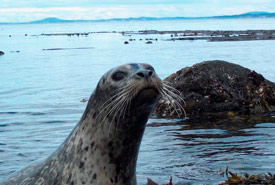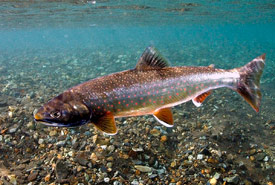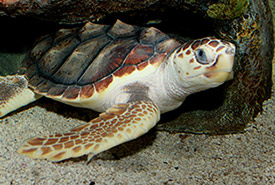Species at risk need our help

Harbour seal (Photo by Ryan Murphy)
As an animal lover, I pride myself on my knowledge of all creatures furry, feathery and scaly. But when the federal government announced that it was adding nine more animals for protection under the Species at Risk Act (SARA), I was surprised to recognize only three.
All nine creatures live in waters across Canada, and perhaps that’s why I’m not familiar with the bulk of them. It’s so easy to overlook the abundance of life found in our lakes, rivers and oceans, which is why it’s especially important that these species are protected.
Curious about the nine additions, I did a bit of research. Here’s what I learned about these at-risk species:
The fish
Five species of fish were added to the list, and I’m ashamed to say that I wasn’t familiar with a single one.

Dolly Varden (Photo by Morgan Bond/University of Washington)
As a member of the salmon and trout family, the Dolly Varden (Western Arctic population) is the only fish on this list that can spend part of its life in the sea. Its home in Canada’s northwestern corner means that it is particularly impacted by climate change, though that process is a threat for almost all of our country’s at-risk species.
Two populations of mountain suckers are now on the list: the Pacific population, which lives in fragmented pockets in British Columbia, and the Milk River population from southern Alberta and Saskatchewan. Both groups face habitat loss and degraded habitat quality as a result of agricultural land use, development and climate change.
Possible changes to their habitat are also why the Rocky Mountain sculpin (Westslope populations) and the redside dace were added. More than 80 per cent of redside dace are found in the Greater Toronto Area, where rapid urban development threatens to destroy the streams in which this fish live.
The Rocky Mountain sculpin is typically found in shallow, slow-moving water with a rocky bottom. Disruption from road construction and maintenance, as well as motorized recreational traffic, are putting this BC resident at risk.
The marine mammals
Here are the two animals on the SARA list that I, and likely most Canadians, am familiar with: the harbour seal (Lacs des Loups Marins subspecies) and the beluga whale (Cumberland Sound population). The former is the only harbour seal population that lives exclusively in fresh water. As few as 50 of these unique seals swim in the lakes and rivers of Nunavik, Quebec, where their primary threat is the possible construction of hydro-electric dams.
Like all belugas, the Baffin Island’s Cumberland Sound population uses echolocation to find its food. However, increased boat traffic in Canada’s North due to, you guessed it, climate change, is disturbing the whales’ ability to use that sense, putting them at risk for starvation.

Loggerhead sea turtle (Photo by Brian Gratwicke)
The reptile
While I was already acquainted with the loggerhead sea turtle, I was surprised to learn that this species lives in Atlantic Canada; likely the northern limit of this hard-shelled marine turtle’s range. Found in most of the world’s oceans, the loggerhead’s numbers have been steadily declining due to the loss of its nesting habitat, poaching and ending up as bycatch (where the species is caught accidently).
The mollusc
Hands up if you’ve heard of the Atlantic mud-piddock before. By far the most unknown creature on this list, it is found in the mud in a specific section of the Bay of Fundy. Changes to its ocean floor home, resulting from storms, human activity and, again, climate change, are threatening to shrink that territory even further.


